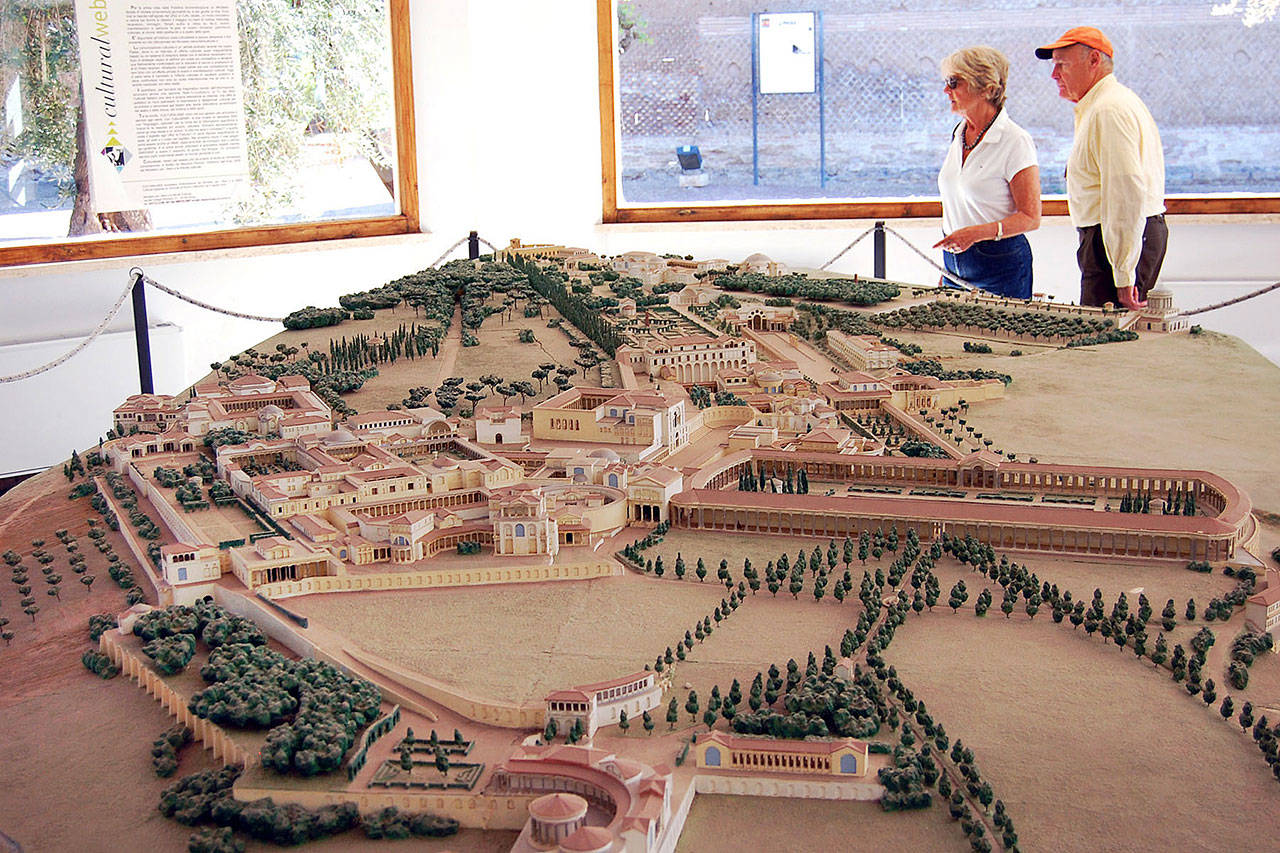When travel dreams take people to Europe, Italy is often their first stop. There’s something seductively charming about this country, its people and “la dolce vita.” I always feel at home in Italy, whether struggling onto a crowded bus in Rome, navigating the fun chaos of Naples, sipping a cocktail in a Venetian bar or sitting on the banister of Florence’s Ponte Vecchio for a midnight street-music concert.
But I also seek escapes from Italy’s urban intensity. When I’m in Rome, I like to travel about 18 miles east to the hill town of Tivoli, a popular retreat since ancient times. Today it’s famous for two very different villas: Hadrian’s Villa, a Roman emperor’s countryside getaway, and Villa d’Este, the lush and watery 16th-century residence of a Catholic cardinal.
Hadrian, who ruled from A.D. 117-138, had a perfectly good villa in Rome, but he preferred to live outside the capital and toward the end of his reign he lived full time at Tivoli. Just as Louis XIV governed France from Versailles rather than Paris, Hadrian ruled Rome from this villa complex of more than 300 evocative acres.
An architect, lover of Greek culture and great traveler, Hadrian envisioned the site as a microcosm of the lands he ruled, which at that point stretched from Great Britain to the Euphrates River. In the spirit of Legoland and Las Vegas, he re-created famous structures from around the world, producing a kind of diorama of his empire.
By the time Hadrian was finished, he had erected more than 30 buildings and created extensive gardens. With libraries, temples, baths, theaters and palaces for himself and his friends and staff, the estate was completely self-contained.
Although most buildings have long since vanished, you can feel Hadrian’s hand in some remaining structures. The emperor surrounded a rectangular water basin — meant to represent the Nile — with columns and statues, including copies of the caryatids he had admired at the Acropolis. At one end he built a temple in memory of his close friend (and perhaps lover) Antinous, who had tragically drowned in the Nile.
Regrettably, with the fall of the empire, this “Versailles of Ancient Rome” was first plundered by barbarians and then by Renaissance big shots, who all wanted something classical in their courtyards. They even burned the marble to make lime for cement. The scavenged art wound up in museums throughout Europe. (Some statues ended up across town, at the Villa d’Este.)
Much later, in 1550, another patron of the arts, Cardinal Ippolito d’Este, further transformed the Tivoli landscape. Even though he was a man of the cloth, Ippolito, cultured and wealthy, lived like a secular prince. When he lost a closely contested election to be the next pope in 1549, he consoled himself by building his sumptuous villa in Tivoli. He cleared a Benedictine convent from the site and erected a luxurious Renaissance palace, with elaborately frescoed walls and ceilings.
But the main attraction is the spectacular garden (which wasn’t fully installed until after Ippolito’s death). A hallmark of Italian design, it clings to a steep hill cascading with pools, streams, waterfalls and thundering fountains. Towering cypress, boxwood hedges, Roman statuary and pleasant paths direct the eye toward stately vistas all around.
Creating such an elaborate water park required the collaboration of a garden architect (to lay out the garden), a hydraulic engineer (to get water to the site) and a plumber (who made sure the fountains worked). At Tivoli, the hillside site was massively excavated and re-engineered so the water features could be gravity-fed.
Pirro Ligorio, Tivoli’s architect, was conveniently also excavating Hadrian’s Villa at the same time. That site provided much in inspiration — and raw material — for the fountains of Villa d’Este. Ligorio basically used Hadrian’s Villa as a quarry to provide statuary and decorative stonework for his vision.
After Ipplito’s death, the estate was passed down in the Este family, but by the 19th century the house was in disrepair and the fountains plugged up. Now in the hands of the Italian state, it’s been completely restored, with all of its fabulous water features back in operation.
While Hadrian’s Villa is about haunting ruins and a storied history, Villa d’Este is simply beautiful and relaxing (and is especially appealing when it’s sweltering in Rome). The two sights complement each other well and combine to make a satisfying day trip from Rome. An easy subway/bus combination gets you from the city to Tivoli, where a public bus connects the two villas.
When I’m in Italy, I savor my cappuccino and imagine what it was like centuries ago. At Tivoli, I can ramble through the rabble and rubble, mentally resurrecting those ancient stones. Escaping the hubbub in Rome, I get chummy with the winds of the past — and connect with the pleasures of the moment.
Talk to us
> Give us your news tips.
> Send us a letter to the editor.
> More Herald contact information.

























